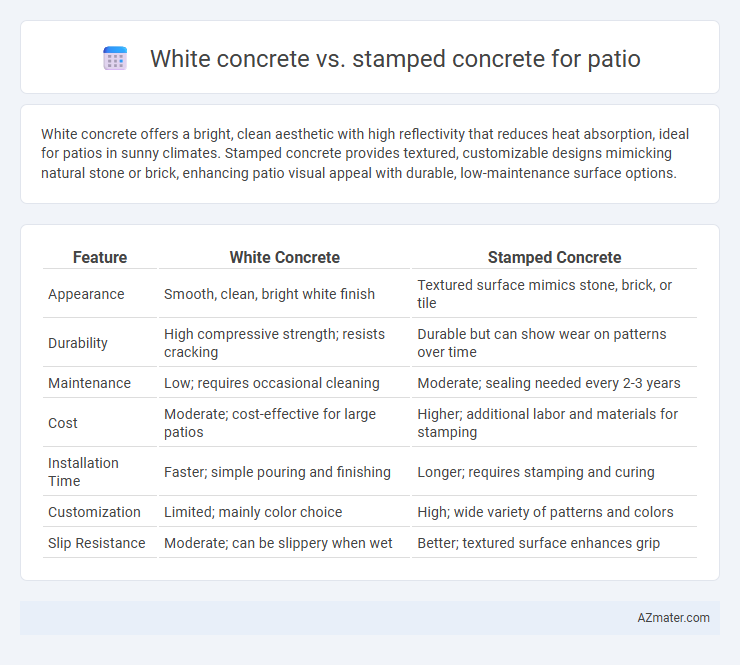White concrete offers a bright, clean aesthetic with high reflectivity that reduces heat absorption, ideal for patios in sunny climates. Stamped concrete provides textured, customizable designs mimicking natural stone or brick, enhancing patio visual appeal with durable, low-maintenance surface options.
Table of Comparison
| Feature | White Concrete | Stamped Concrete |
|---|---|---|
| Appearance | Smooth, clean, bright white finish | Textured surface mimics stone, brick, or tile |
| Durability | High compressive strength; resists cracking | Durable but can show wear on patterns over time |
| Maintenance | Low; requires occasional cleaning | Moderate; sealing needed every 2-3 years |
| Cost | Moderate; cost-effective for large patios | Higher; additional labor and materials for stamping |
| Installation Time | Faster; simple pouring and finishing | Longer; requires stamping and curing |
| Customization | Limited; mainly color choice | High; wide variety of patterns and colors |
| Slip Resistance | Moderate; can be slippery when wet | Better; textured surface enhances grip |
Introduction to White Concrete and Stamped Concrete
White concrete offers a sleek, modern appearance with its bright, clean finish ideal for minimalist patio designs, utilizing white Portland cement for enhanced brightness and durability. Stamped concrete mimics the look of natural materials like stone, brick, or wood through textured patterns and colored stains, providing versatility and aesthetic appeal for custom outdoor spaces. Both options deliver durable surfaces but differ in visual style and installation techniques, influencing the overall ambiance and maintenance needs of the patio area.
Visual Appeal: Comparing Aesthetics
White concrete patios offer a clean, minimalist look with a smooth, uniform surface that brightens outdoor spaces and complements modern design styles. Stamped concrete provides a highly decorative appearance by mimicking natural materials like stone, brick, or wood, adding texture and intricate patterns for a more dynamic and customized patio aesthetic. The choice between white and stamped concrete ultimately depends on whether the preference is for sleek simplicity or detailed visual interest.
Durability and Longevity
White concrete offers exceptional durability due to its high cement content and resistance to cracking, making it a long-lasting choice for patios exposed to harsh weather conditions. Stamped concrete, although visually appealing with customizable patterns and textures, may require more maintenance over time to prevent surface wear and fading, potentially affecting its longevity. Both materials can provide sturdy patios, but white concrete generally outperforms stamped concrete in terms of long-term durability and structural integrity.
Installation Process Differences
White concrete patios require precise mixing and curing to avoid discoloration or uneven tones, often demanding skilled labor to maintain its bright, clean appearance. Stamped concrete installation involves pouring a base slab followed by pressing detailed patterns and textures into the surface before curing, offering decorative customization but requiring timeliness to prevent premature hardening. Both methods need thorough site preparation, but stamped concrete typically demands more intricate finishing techniques to achieve its aesthetic effect.
Maintenance Requirements
White concrete patios require minimal maintenance with regular cleaning and occasional sealing to prevent staining and color fading under UV exposure. Stamped concrete demands more frequent upkeep, including resealing every 2-3 years to maintain the textured pattern and resist wear from weather and foot traffic. Both options benefit from prompt stain removal and protection against moisture to extend their durability and aesthetic appeal.
Cost Analysis: White vs Stamped Concrete
White concrete typically costs between $8 to $12 per square foot, making it a more affordable option for patio surfaces compared to stamped concrete, which ranges from $12 to $18 per square foot due to additional labor and materials required for texturing and coloring. Maintenance expenses can also impact long-term costs; white concrete generally requires sealing and occasional cleaning to prevent staining, while stamped concrete may need more frequent resealing to preserve its patterned appearance. Considering both initial investment and upkeep, white concrete offers a cost-effective solution, whereas stamped concrete provides enhanced aesthetic value at a higher price point.
Slip Resistance and Safety
White concrete offers a smooth, durable surface that can become slippery when wet, requiring the application of anti-slip coatings or textured finishes to enhance safety for patios. Stamped concrete inherently provides better slip resistance due to its textured patterns, mimicking natural stone or brick, which create grip and reduce the risk of slips. Choosing stamped concrete for patio surfaces improves safety by minimizing slip hazards, especially in wet or humid conditions, making it a preferred option for residential and commercial outdoor spaces.
Climate and Weather Considerations
White concrete offers superior heat reflectivity, making it ideal for patios in hot climates as it helps reduce surface temperature and improve comfort. Stamped concrete, while aesthetically versatile, can absorb more heat, potentially causing higher surface temperatures during sunny weather. Both materials require weather-resistant sealants to prevent cracking and damage in freeze-thaw cycles common in colder climates.
Customization and Design Options
White concrete offers a pristine, modern aesthetic with a smooth, sleek finish that can be tinted for subtle color variations, ideal for minimalist patio designs. Stamped concrete provides extensive customization through patterns and textures that mimic natural stone, brick, or wood, enabling detailed and intricate patio designs tailored to diverse styles. Each option enhances curb appeal, but stamped concrete excels in creating unique, decorative surfaces, while white concrete emphasizes clean lines and contemporary simplicity.
Which Patio Concrete is Right for You?
White concrete offers a sleek, modern aesthetic with high durability and low maintenance, making it ideal for patios in bright, sunny climates due to its heat-reflective properties. Stamped concrete provides customizable textures and patterns that mimic natural stone, brick, or wood, enhancing visual appeal and complementing traditional or rustic home designs. Choosing between white concrete and stamped concrete depends on your desired patio style, budget constraints, and long-term maintenance preferences.

Infographic: White concrete vs Stamped concrete for Patio
 azmater.com
azmater.com